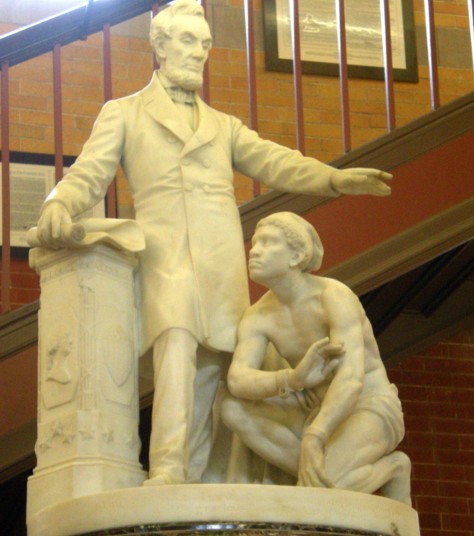 The statue of Abraham Lincoln in Lincoln Park is not only one of the most iconic images of Capitol Hill, but almost certainly also its most controversial. From the moment of its unveiling by President Grant in 1876 until today, people have puzzled over the image of a crouching slave towered over by the tall statue of Lincoln. Today we’ll look at how it came to be this statue.
The statue of Abraham Lincoln in Lincoln Park is not only one of the most iconic images of Capitol Hill, but almost certainly also its most controversial. From the moment of its unveiling by President Grant in 1876 until today, people have puzzled over the image of a crouching slave towered over by the tall statue of Lincoln. Today we’ll look at how it came to be this statue.
On April 15, 1865 Charlotte Scott, freed slave from Virginia, offered five dollars toward a monument to the martyred president. Scott’s money was sent to a James Yeatman, who wrote an article about this new initiative, while placing the Western Sanitary Commission – of which Yeatman was the director – in charge of the collection and dispersal of the money. The Western Sanitary Commission (WSC), based in St. Louis, had been actively involved in helping the sick and wounded of the war, and had the infrastructure necessary to deal with large sums of money. And the money flowed in, with the coffers swelling to almost $17,000 dollars.
What they did not have was a plan as to how to spend it. Over the next 10 years, at least two designs were offered, and discarded – mainly because both were too complicated and thus too expensive to execute. In order to get around this problem, the WSC tried to join in with others who were collecting money to build a Lincoln memorial. This did nothing except to delay further work.
Over four years after Lincoln’s assassination,William Eliot, the founder of the WSC, wrote to Yeatman, saying that they needed to strike out on their own, and suggested a statue he had seen in the studio of Thomas Ball while in Italy.
Ball was born in Massachusetts, but had moved to Florence shortly after the Civil War. By then he had completed numerous commissions, including a statue of George Washington on his horse. The model that had caught Eliot’s eye was in a much simpler vein. It showed Lincoln freeing a slave, and was thus – in Eliot’s view – exactly the image that was needed. Ball had created this group not for any particular reason other than to honor the assassinated president.
A few years later, having now finally freed themselves of other groups, Yeatman acceded to Eliot’s wishes and offered Ball the commission. Yeatman and the other commissioners did, however, request a few changes: the freed slave, they felt, was too passive; they wished his arm to be straight. Furthermore, the liberty cap was to be removed; and finally, the face was to be remodeled to match the features of Archer Alexander, a fugitive slave who had found safety in the house of William Eliot.
Ball acceded to these requests, and finally on April 14, 1876 – a day less than 11 years after the first money was donated to the cause – the statue was unveiled in Lincoln Park, where it stands today.

